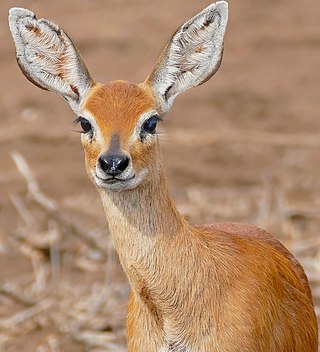
The Integrated Taxonomic Information System (ITIS) is an American partnership of federal agencies designed to provide consistent and reliable information on the taxonomy of biological species. ITIS was originally formed in 1996 as an interagency group within the US federal government, involving several US federal agencies, and has now become an international body, with Canadian and Mexican government agencies participating. The database draws from a large community of taxonomic experts. Primary content staff are housed at the Smithsonian National Museum of Natural History and IT services are provided by a US Geological Survey facility in Denver. The primary focus of ITIS is North American species, but many biological groups exist worldwide and ITIS collaborates with other agencies to increase its global coverage.

Raphicerus is a genus of small antelopes of the tribe Neotragini.
The Catalogue of Life is an online database that provides an index of known species of animals, plants, fungi, and microorganisms. It was created in 2001 as a partnership between the global Species 2000 and the American Integrated Taxonomic Information System. The Catalogue is used by research scientists, citizen scientists, educators, and policy makers. The Catalogue is also used by the Biodiversity Heritage Library, the Barcode of Life Data System, Encyclopedia of Life, and the Global Biodiversity Information Facility. The Catalogue currently compiles data from 165 peer-reviewed taxonomic databases that are maintained by specialist institutions around the world. As of September 2022, the COL Checklist lists 2,067,951 of the world's 2.2m extant species known to taxonomists on the planet at present time.
Aphanophleps is a genus of moths in the family Geometridae.
Hyocephalidae are a small family of Heteroptera which are endemic to Australia.
Species 2000 is a federation of database organizations around the world that compiles the Catalogue of Life, a comprehensive checklist of the world's species, in partnership with the Integrated Taxonomic Information System (ITIS). The creation of Species 2000 was initiated by Frank Bisby and colleagues at the University of Reading in the UK in 1997 and the Catalogue of Life was first published in 2001. While administrators and member organizations of Species 2000 are located around the world, the secretariat is located at the Naturalis Biodiversity Center in Leiden, Netherlands.
Alfred Frank Millidge was a British arachnologist who wrote several works on spiders. One of his best-known might be British Spiders, volumes I and II, which he co-wrote with G. H. Locket. In 1983, he became the first person to describe the spider species Walckenaeria crocea.
Glyptothorax alaknandi is a species of catfish that was first described by Tilak, 1969. Glyptothorax alaknandi is a species in genus Glyptothorax, family Sisoridae and order Siluriformes. IUCN categorise the species as least concern globally. No subspecies are listed in Catalogue of Life.

Glyptothorax botius is a species of catfish that was first described by Hamilton 1822. Glyptothorax botius is a species in genus Glyptothorax, family Sisoridae and order Siluriformes. IUCN categorise the species as least concern globally. No subspecies are listed in Catalogue of Life.
Glyptothorax cavia is a species of catfish that was first described by Hamilton 1822. Glyptothorax cavia is a species in genus Glyptothorax, family Sisoridae and order Siluriformes. IUCN categorise the species as least concern globally. No subspecies are listed in Catalogue of Life.

Dasineura is a genus of midges in the family Cecidomyiidae, some of which cause galls on plants such as Dasineura crataegi on hawthorn and Dasineura fraxinea on ash.

Naxa textilis is a species of moth which was described by Preyer 1884. Naxa textilis included in the genus Naxa and Geometer moth family. No subspecies are listed in the Catalogue of Life.
Phytobia optabilis is a species of fly in the genus Phytobia. It was described by Kenneth Spencer in 1977. According to Catalogue of Life, there are no known subspecies.
Aagaardia longicalcis is a species of fly discovered by Ole Anton Sæther in 2000. No sub-species specified in Catalogue of Life.
Ablabesmyia phatta is a species of Chironomidae flies described by Egger in 1863. No sub-species specified in Catalogue of Life.
Ablabesmyia infumata is a species of fly described by Edwards in 1931. No sub-species specified in Catalogue of Life.

Ablabesmyia monilis is a Palearctic species of Chironomidae described by Carl Linnaeus, in 1758. No sub-species mentioned in Catalogue of Life. It is found over all of Europe
Ablaberoides crassus is a species of beetles first discovered by Olof Immanuel von Fåhraeus in 1857. No sub-species are listed at the Catalogue of Life.

Typopeltis stimpsonii is an arachnid species first described by Charles Thorold Wood in 1862. Typopeltis stimpsonii is part of the genus Typopeltis and the family Thelyphonidae. No subspecies are listed in the Catalog of Life.
Atyoida is a genus of freshwater shrimp in the family Atyidae. There are four species in the genus, each endemic to a different island group. The type species, Atyoida bisulcata, is endemic to Hawaiʻi and described by John Witt Randall in 1840.






